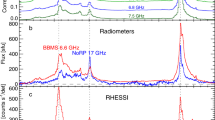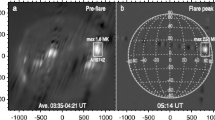Abstract
Our analysis of the observations of the SOL2001-12-26 event, which was related to ground-level enhancement of cosmic-ray intensity GLE63, including microwave spectra and images from the Nobeyama Radioheliograph at 17 and 34 GHz, from the Siberian Solar Radio Telescope at 5.7 GHz, and from the Transition Region and Coronal Explorer in 1600 Å, has led to the following results: A flare ribbon overlapped with the sunspot umbra, which is typical of large particle events. Atypical were i) the long duration of the flare, which lasted more than one hour; ii) the moderate intensity of the microwave burst, which was about \(10^{4}~\mbox{sfu}\); iii) the low peak frequency of the gyrosynchrotron spectrum, which was about 6 GHz; and its insensitivity to the flux increase by more than one order of magnitude. This was accompanied by a nearly constant ratio of the flux emitted by the volume in the high-frequency part of the spectrum to its elevated low-frequency part determined by the area of the source. With the self-similarity of the spectrum, a similarity was observed between the moving microwave sources and the brightest parts of the flare ribbons in 1600 Å images. We compared the 17 GHz and 1600 Å images and confirm that the microwave sources were associated with multiple flare loops, whose footpoints appeared in the ultraviolet as intermittent bright kernels. To understand the properties of the event, we simulated its microwave emission using a system of several homogeneous gyrosynchrotron sources above the ribbons. The scatter between the spectra and the sizes of the individual sources is determined by the inhomogeneity of the magnetic field within the ribbons. The microwave flux is mainly governed by the magnetic flux passing through the ribbons and the sources. The apparent simplicity of the microwave structures is caused by a poorer spatial resolution and dynamic range of the microwave imaging. The results indicate that microwave manifestations of accelerated electrons correspond to the structures observed in thermal emissions, as well-known models predict.












Similar content being viewed by others
References
Alissandrakis, C.E.: 1986, Solar Phys. 104, 207. DOI .
Alissandrakis, C.E., Preka-Papadema, P.: 1984, Astron. Astrophys. 139, 507.
Asai, A., Masuda, S., Yokoyama, T., Shimojo, M., Isobe, H., Kurokawa, H., Shibata, K.: 2002, Astrophys. J. Lett. 578, L91. DOI .
Asai, A., Yokoyama, T., Shimojo, M., Masuda, S., Kurokawa, H., Shibata, K.: 2004, Astrophys. J. 611, 557. DOI .
Aschwanden, M.J.: 2012, Space Sci. Rev. 173, 3. DOI .
Bastian, T.S., Benz, A.O., Gary, D.E.: 1998, Annu. Rev. Astron. Astrophys. 36, 131. DOI .
Bogachev, S.A., Somov, B.V., Kosugi, T., Sakao, T.: 2005, Astrophys. J. 630, 561. DOI .
Brueckner, G.E., Howard, R.A., Koomen, M.J., Korendyke, C.M., Michels, D.J., Moses, J.D., Socker, D.G., Dere, K.P., Lamy, P.L., Llebaria, A., et al.: 1995, Solar Phys. 162, 357. DOI .
Cheng, X., Zhang, J., Liu, Y., Ding, M.D.: 2011, Astrophys. J. Lett. 732, L25. DOI .
Cliver, E.W.: 2006, Astrophys. J. 639, 1206. DOI .
Dierckxsens, M., Tziotziou, K., Dalla, S., Patsou, I., Marsh, M.S., Crosby, N.B., Malandraki, O., Tsiropoula, G.: 2015, Solar Phys. 290, 841. DOI .
Dulk, G.A.: 1985, Annu. Rev. Astron. Astrophys. 23, 169. DOI .
Dulk, G.A., Marsh, K.A.: 1982, Astrophys. J. 259, 350. DOI .
Filippov, B., Golub, L., Koutchmy, S.: 2009, Solar Phys. 254, 259. DOI .
Gopalswamy, N., Xie, H., Yashiro, S., Akiyama, S., Mäkelä, P., Usoskin, I.G.: 2012, Space Sci. Rev. 171, 23. DOI .
Grechnev, V.V.: 2003, Solar Phys. 213, 103. DOI .
Grechnev, V.V.: 2004, In: Stepanov, A.V., Benevolenskaya, E.E., Kosovichev, A.G. (eds.) Multi-Wavelength Investigations of Solar Activity, IAU Symp. 223, 625. DOI .
Grechnev, V.V., Kochanov, A.A.: 2016, Solar. Phys. 291. DOI (Article I).
Grechnev, V.V., Nakajima, H.: 2002, Astrophys. J. 566, 539. DOI .
Grechnev, V.V., Kundu, M.R., Nindos, A.: 2006, Publ. Astron. Soc. Japan 58, 47. DOI .
Grechnev, V.V., Lesovoi, S.V., Smolkov, G.Y., Krissinel, B.B., Zandanov, V.G., Altyntsev, A.T., Kardapolova, N.N., Sergeev, R.Y., Uralov, A.M., Maksimov, V.P., Lubyshev, B.I.: 2003, Solar Phys. 216, 239. DOI .
Grechnev, V.V., Kurt, V.G., Chertok, I.M., Uralov, A.M., Nakajima, H., Altyntsev, A.T., Belov, A.V., Yushkov, B.Y., Kuznetsov, S.N., Kashapova, L.K., Meshalkina, N.S., Prestage, N.P.: 2008, Solar Phys. 252, 149. DOI .
Grechnev, V.V., Uralov, A.M., Chertok, I.M., Kuzmenko, I.V., Afanasyev, A.N., Meshalkina, N.S., Kalashnikov, S.S., Kubo, Y.: 2011, Solar Phys. 273, 433. DOI .
Grechnev, V.V., Kiselev, V.I., Uralov, A.M., Meshalkina, N.S., Kochanov, A.A.: 2013a, Publ. Astron. Soc. Japan 65(SP1), S9. DOI .
Grechnev, V.V., Meshalkina, N.S., Chertok, I.M., Kiselev, V.I.: 2013b, Publ. Astron. Soc. Japan 65(SP1), S4. DOI .
Grechnev, V.V., Uralov, A.M., Chertok, I.M., Slemzin, V.A., Filippov, B.P., Egorov Ya, I., Fainshtein, V.G., Afanasyev, A.N., Prestage, N., Temmer, M.: 2014, Solar Phys. 289, 1279. DOI .
Grechnev, V.V., Kiselev, V.I., Meshalkina, N.S., Chertok, I.M.: 2015a, Solar Phys. 290, 2827. DOI .
Grechnev, V.V., Uralov, A.M., Kuzmenko, I.V., Kochanov, A.A., Chertok, I.M., Kalashnikov, S.S.: 2015b, Solar Phys. 290, 129. DOI .
Grechnev, V.V., Uralov, A.M., Kochanov, A.A., Kuzmenko, I.V., Prosovetsky, D.V., Egorov, Y.I., Fainshtein, V.G., Kashapova, L.K.: 2016, Solar Phys. 291, 1173. DOI .
Grechnev, V.V., Kiselev, V.I., Uralov, A.M., Klein, K.-L., Kochanov, A.A.: 2017, in preparation. Solar Phys. (Article III).
Hanaoka, Y.: 1996, Solar Phys. 165, 275. DOI .
Hanaoka, Y.: 1997, Solar Phys. 173, 319. DOI .
Handy, B.N., Acton, L.W., Kankelborg, C.C., Wolfson, C.J., Akin, D.J., Bruner, M.E., Caravalho, R., Catura, R.C., Chevalier, R., Duncan, D.W., et al.: 1999, Solar Phys. 187, 229. DOI .
Hurford, G.J., Schmahl, E.J., Schwartz, R.A., Conway, A.J., Aschwanden, M.J., Csillaghy, A., Dennis, B.R., Johns-Krull, C., Krucker, S., Lin, R.P., et al.: 2002, Solar Phys. 210, 61. DOI .
Ji, H., Wang, H., Liu, C., Dennis, B.R.: 2008, Astrophys. J. 680, 734. DOI .
Kahler, S.W.: 1982, J. Geophys. Res. 87, 3439. DOI .
Kallenrode, M.-B.: 2003, J. Phys. G, Nucl. Part. Phys. 29, 965. DOI .
Koshiishi, H., Enome, S., Nakajima, H., Shibasaki, K., Nishio, M., Takano, T., Hanaoka, Y., Torii, C., Sekiguchi, H., Kawashima, S., et al.: 1994, Publ. Astron. Soc. Japan 46, L33.
Kosugi, T., Dennis, B.R., Kai, K.: 1988, Astrophys. J. 324, 1118. DOI .
Kosugi, T., Makishima, K., Murakami, T., Sakao, T., Dotani, T., Inda, M., Kai, K., Masuda, S., Nakajima, H., Ogawara, Y., Sawa, M., Shibasaki, K.: 1991, Solar Phys. 136, 17. DOI .
Krucker, S., Christe, S., Glesener, L., Ishikawa, S-n., Ramsey, B., Takahashi, T., Watanabe, S., Saito, S., Gubarev, M., Kilaru, K., et al.: 2014, Astrophys. J. Lett. 793, L32. DOI .
Kundu, M.R., Nindos, A., Grechnev, V.V.: 2004, Astron. Astrophys. 420, 351. DOI .
Kundu, M.R., Grechnev, V.V., White, S.M., Schmahl, E.J., Meshalkina, N.S., Kashapova, L.K.: 2009, Solar Phys. 260, 135. DOI .
Kuznetsov, A.A., Nita, G.M., Fleishman, G.D.: 2011, Astrophys. J. 742, 87. DOI .
Lee, J.W., Gary, D.E., Zirin, H.: 1994, Solar Phys. 152, 409. DOI .
Lee, J., Nita, G.M., Gary, D.E.: 2009, Astrophys. J. 696, 274. DOI .
Lin, R.P., Dennis, B.R., Hurford, G.J., Smith, D.M., Zehnder, A., Harvey, P.R., Curtis, D.W., Pankow, D., Turin, P., Bester, M., et al.: 2002, Solar Phys. 210, 3. DOI .
Liu, C., Lee, J., Gary, D.E., Wang, H.: 2007, Astrophys. J. Lett. 658, L127. DOI .
Masson, S., Pariat, E., Aulanier, G., Schrijver, C.J.: 2009, Astrophys. J. 700, 559. DOI .
Masuda, S., Kosugi, T., Hudson, H.S.: 2001, Solar Phys. 204, 55. DOI .
Melnikov, V.F., Magun, A.: 1998, Solar Phys. 178, 153. DOI .
Melnikov, V.F., Gary, D.E., Nita, G.M.: 2008, Solar Phys. 253, 43. DOI .
Meshalkina, N.S., Uralov, A.M., Grechnev, V.V., Altyntsev, A.T., Kashapova, L.K.: 2009, Publ. Astron. Soc. Japan 61, 791. DOI .
Metcalf, T.R., Alexander, D., Hudson, H.S., Longcope, D.W.: 2003, Astrophys. J. 595, 483. DOI .
Miklenic, C.H., Veronig, A.M., Vršnak, B.: 2009, Astron. Astrophys. 499, 893. DOI .
Miklenic, C.H., Veronig, A.M., Vršnak, B., Hanslmeier, A.: 2007, Astron. Astrophys. 461, 697. DOI .
Nakajima, H., Sekiguchi, H., Sawa, M., Kai, K., Kawashima, S.: 1985, Publ. Astron. Soc. Japan 37, 163.
Nakajima, H., Nishio, M., Enome, S., Shibasaki, K., Takano, T., Hanaoka, Y., Torii, C., Sekiguchi, H., Bushimata, T., Kawashima, S., et al.: 1994, Proc. IEEE 82, 705. DOI .
Neupert, W.M.: 1968, Astrophys. J. Lett. 153, L59. DOI .
Nishio, M., Yaji, K., Kosugi, T., Nakajima, H., Sakurai, T.: 1997, Astrophys. J. 489, 976. DOI .
Nitta, N.V., Liu, Y., DeRosa, M.L., Nightingale, R.W.: 2012, Space Sci. Rev. 171, 61. DOI .
Reznikova, V.E., Melnikov, V.F., Ji, H., Shibasaki, K.: 2010, Astrophys. J. 724, 171. DOI .
Scherrer, P.H., Bogart, R.S., Bush, R.I., Hoeksema, J.T., Kosovichev, A.G., Schou, J., Rosenberg, W., Springer, L., Tarbell, T.D., Title, A., et al.: 1995, Solar Phys. 162, 129. DOI .
Smolkov, G.I., Pistolkors, A.A., Treskov, T.A., Krissinel, B.B., Putilov, V.A.: 1986, Astrophys. Space Sci. 119, 1. DOI .
Stähli, M., Gary, D.E., Hurford, G.J.: 1989, Solar Phys. 120, 351. DOI .
Thalmann, J.K., Su, Y., Temmer, M., Veronig, A.M.: 2015, Astrophys. J. Lett. 801, L23. DOI .
Torii, C., Tsukiji, Y., Kobayashi, S., Yoshimi, N., Tanaka, H., Enome, S.: 1979, Proc. Res. Inst. Atmos. 26, 129.
Trottet, G., Samwel, S., Klein, K.-L., Dudok de Wit, T., Miteva, R.: 2015, Solar Phys. 290, 819. DOI .
Tzatzakis, V., Nindos, A., Alissandrakis, C.E.: 2008, Solar Phys. 253, 79. DOI .
Uralov, A.M., Grechnev, V.V., Rudenko, G.V., Myshyakov, I.I., Chertok, I.M., Filippov, B.P., Slemzin, V.A.: 2014, Solar Phys. 289, 3747. DOI .
Vilmer, N., MacKinnon, A.L., Hurford, G.J.: 2011, Space Sci. Rev. 159, 167. DOI .
White, S.M., Krucker, S., Shibasaki, K., Yokoyama, T., Shimojo, M., Kundu, M.R.: 2003, Astrophys. J. Lett. 595, L111. DOI .
Yashiro, S., Gopalswamy, N., Michalek, G., St. Cyr, O.C., Plunkett, S.P., Rich, N.B., Howard, R.A.: 2004, J. Geophys. Res. 109, A07105. DOI .
Zimovets, I.V., Kuznetsov, S.A., Struminsky, A.B.: 2013, Astron. Lett. 39, 267. DOI .
Zimovets, I., Vilmer, N., Chian, A.C.-L., Sharykin, I., Struminsky, A.: 2012, Astron. Astrophys. 547, A6. DOI .
Acknowledgments
We thank N.V. Nitta for discussions and the reviewer for useful remarks. We thank the instrument teams managing SSRT, NoRH, and NoRP; TRACE (NASA); SOHO/MDI and LASCO (ESA and NASA), GOES; USAF RSTN Network; NICT (Japan); and the CME Catalog at the CDAW Data Center (NASA and Catholic University of America). In memory of T.A. Treskov, one of the main developers of the SSRT, and N.N. Kardapolova, who managed SSRT observations for many years. This study was supported by the Russian State Contract No. II.16.1.6. A. Kochanov was supported by the Russian Foundation of Basic Research under grants 15-32-20504 mol-a-ved and 15-02-03717. V. Kiselev was supported by the Marie Curie PIRSES-GA-2011-295272 RadioSun project.
Author information
Authors and Affiliations
Corresponding author
Ethics declarations
Disclosure of Potential Conflicts of Interest
The authors declare that they have no conflicts of interest.
Electronic Supplementary Material
Rights and permissions
About this article
Cite this article
Grechnev, V., Uralov, A.M., Kiselev, V.I. et al. The 26 December 2001 Solar Eruptive Event Responsible for GLE63. II. Multi-Loop Structure of Microwave Sources in a Major Long-Duration Flare. Sol Phys 292, 3 (2017). https://doi.org/10.1007/s11207-016-1025-8
Received:
Accepted:
Published:
DOI: https://doi.org/10.1007/s11207-016-1025-8




